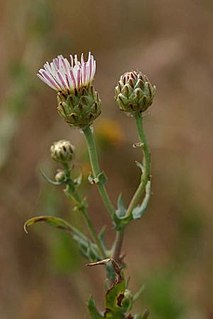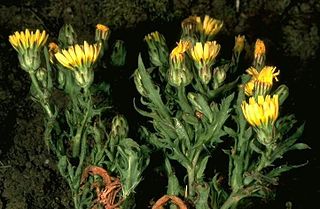
Anacapa Island is a small volcanic island located about 11 miles (18 km) off the coast of Port Hueneme, California, in Ventura County. The island is composed of a series of narrow islets 6 mi (10 km) long, oriented generally east–west and 5 mi (8 km) east of Santa Cruz Island. The three main islets, East, Middle and West Anacapa, are collectively known as The Anacapas by some authors. All three islets have precipitous cliffs, dropping off steeply into the sea.

Malacothrix is a genus of plants in the tribe Cichorieae within the family Asteraceae. They are known generally as desert dandelions or desertdandelions. Most are native to western North America although a few have been introduced to South America. Several are found only on offshore islands in the Pacific.

Lasthenia burkei is a rare species of flowering plant in the family Asteraceae known by the common names Burke's goldfields and Burke's baeria.

Hazardia detonsa is a rare species of shrub in the family Asteraceae known by the common name island bristleweed. It is endemic to the Channel Islands of California, having been found on 4 islands.
Layia leucopappa is a rare species of flowering plant in the family Asteraceae known by the common name Comanche Point tidytips, or Comanche Point layia.

Constancea is a monotypic genus of flowering plants in the family Asteraceae containing the single species Constancea nevinii, which is known by the common name Nevin's woolly sunflower. It is endemic to three of the Channel Islands of California, where it grows in coastal scrub habitat. This is a small shrub or subshrub generally growing up to one or 1.5 meters tall, and taller when an erect form, with a branching, woolly stem. The whitish, woolly oval leaves may be up to 20 centimeters long and are divided into many narrow lobes with edges curled under. The inflorescence is a cluster of 10 to 50 or more small flower heads, each on a short peduncle. The flower head has a center of hairy, glandular, star-shaped yellow disc florets and a fringe of four to nine yellow ray florets, each about 2 millimeters long. The fruit is an achene a few millimeters long with a small pappus at the tip.

Lessingia germanorum is a rare species of flowering plant in the family Asteraceae known by the common name San Francisco lessingia. It is endemic to California, where it is known from four populations in the Presidio of San Francisco and one occurrence on San Bruno Mountain south of San Francisco. It is a state and federally listed endangered species. The already rare plant is endangered by many processes, including invasive species, development, sand mining, off-road vehicles and bulldozers, habitat fragmentation, trampling, and pollution, as well as stochastic events.
Lessingia micradenia is a rare species of flowering plant in the family Asteraceae known by the common name Mt. Tamalpais lessingia. It is endemic to the San Francisco Bay Area of California, where it occurs in areas with serpentine soils. The species is divided into two rare varieties, each with a limited occurrence on opposite sides of the Bay Area. Lessingia micradenia var. glabrata is found in several locations across Santa Clara County south of San Jose, while var. micradenia is known only from a few spots around Mount Tamalpais in Marin County.
Malacothrix clevelandii is a species of flowering plant in the family Asteraceae known by the common name Cleveland's desertdandelion. It is native to parts of the southwestern United States and Baja California, where it can be found most often in chaparral, including cleared and disturbed areas such as slopes recently burned by wildfire. The plant is also found in southern South America where it is an introduced species. It is an annual herb producing a flowering stem up to about 35 centimeters in maximum height. The toothed leaves are largest at the base of the plant, and reduced farther up. The inflorescence is an array of flower heads each bearing rings of pale yellow ray florets roughly half a centimeter long.

Malacothrix coulteri is a species of flowering plant in the family Asteraceae known by the common name snake's head, or snake's head desertdandelion. It is native to the southwestern United States is also found in southern South America where it is an introduced species. Its native habitat includes desert, grassland, chaparral, and other open, sandy areas. It is an annual herb producing a waxy, upright flowering stem up to about 50 centimeters in maximum height. The leaves, which are mostly located near the base of the stem, are toothed or not. The inflorescence is an array of flower heads with nearly spherical involucres of scale-like phyllaries one to two centimeters wide. The bracts are green, often with dark striping or marking. The yellow or white ray florets are about a centimeter long.

Malacothrix floccifera is a species of flowering plant in the family Asteraceae known by the common name woolly desertdandelion. It is native to many of the northern and central mountain ranges of California, including the Sierra Nevada, where its distribution extends into Nevada. Its habitat includes forest, woodland, and chaparral. It is an annual herb producing a hairless flowering stem up to about 42 centimeters in maximum height. The fleshy oblong leaves are cut into teeth or lobes and have cottony patches of woolly fibers. The inflorescence is an array of flower heads lined with hairless phyllaries. The ray florets are up to 1.5 centimeters long and are often white, but sometimes yellow.
Malacothrix incana is an uncommon species of flowering plant in the family Asteraceae known by the common name dunedelion. It is endemic to California, where it grows only in sand dunes on the beaches of the Channel Islands and isolated spots along the mainland coastline in San Luis Obispo and Santa Barbara Counties. The type specimen was collected in San Diego, but the plant no longer occurs there. This is a perennial herb forming a leafy mound up to about 70 centimeters in maximum height. It may be hairless to densely hairy. The leaves are smooth-edged or have dull lobes. Leaves at the base of the stem are similar to those distal. The inflorescence is an array of flower heads lined with hairless phyllaries. The ray florets are one or two centimeters long and yellow in color.
Malacothrix indecora is a rare species of flowering plant in the family Asteraceae known by the common name Santa Cruz Island desertdandelion. It is endemic to the Channel Islands of California, where it is known from only a few populations on three of the eight islands. As of 2000, there were three occurrences on San Miguel Island, two on Santa Rosa Island, and one on Santa Cruz Island. It grows on the bluffs and rocky coastal grasslands of the islands. Like many Channel Islands endemics, this plant is naturally limited in distribution and has been threatened by the presence of destructive introduced mammals, in this case, feral pigs. The plant became a federally listed endangered species in 1997. This is a mat-forming annual herb which spreads low to the ground no more than about 10 centimeters high. The fleshy leaves have dull lobes. The inflorescence is an array of flower heads lined with oval-shaped phyllaries. The ray florets are under a centimeter long and yellow in color.

Malacothrix saxatilis is a species of flowering plant in the family Asteraceae known by the common names cliff desertdandelion or cliff aster. It is endemic to California, where it grows in the central and southern coastal hills and mountain ranges. It is a perennial herb growing 30 to 60 centimeters tall from a rhizome and caudex unit. The leaves are variable in size and shape and may be lobed or not. The inflorescence is an array of flower heads lined with lance-shaped phyllaries. The ray florets are 1 or 2 centimeters long and white in color.

Malacothrix squalida is a rare species of flowering plant in the family Asteraceae known by the common name Santa Cruz desertdandelion. It is endemic to Santa Cruz and Anacapa Islands, two of the eight Channel Islands of California, where it grows on rocky seaside bluffs and cliffs. The plant is very limited in distribution and today exists only in degraded habitat on these two small islands. It was last collected from Santa Cruz Island in 1968, and two populations were noted on Anacapa Island in 1998; in drought years there may be no plants at all. It became a federally listed endangered species in 1997. This is an annual herb growing a hairless, waxy stem 20 to 30 centimeters in maximum height. The leaves are sharply lobed. The inflorescence is an array of flower heads lined with oval-shaped phyllaries. The ray florets are 1 to 2 centimeters and light yellow in color.
Munzothamnus is a monotypic genus of flowering plants in the family Asteraceae containing the single species Munzothamnus blairii, which is known by the common name Blair's wirelettuce, or Blair's munzothamnus. It is endemic to San Clemente Island, one of the Channel Islands of California. It grows along steep, rocky cliffsides and canyons on the island. It is a shrub producing a fleshy, woolly stem usually over a meter in height, often approaching two meters. Leaves occur in tufts at the ends of the stem branches. They are up to 15 centimeters long, oblong in shape, and sometimes very shallowly lobed. They are woolly when new but lose their hairs and become shiny green with age. The inflorescence is a large array of up to 35 flower heads. Each head has a cylindrical base under a centimetre long and contains 9 to 12 light lavender or pinkish flowers. Each flower is a ray floret with an erect tube and a strap-shaped ligule with a toothed tip. The ligule is just under a centimetre long. The fruit is a cylindrical, ribbed achene with a white pappus.
Pseudobahia bahiifolia is a rare species of flowering plant in the family Asteraceae known by the common name Hartweg's golden sunburst.
Pseudobahia peirsonii is a rare species of flowering plant in the family Asteraceae known by the common names San Joaquin adobe sunburst and Tulare pseudobahia. It is endemic to California, where it is known from a few mostly small occurrences along the southeastern side of the San Joaquin Valley where it rises into the Sierra Nevada foothills. It grows in grassland and oak woodland habitat. It prefers heavy adobe clay soils. The plant became a federally listed threatened of the United States in 1997.

Erigeron maniopotamicus is a rare species of flowering plant in the family Asteraceae known by the common name Mad River fleabane. It is endemic to northwestern California, where it is known from only four locations in Humboldt and Trinity Counties.
Heterotheca monarchensis is a rare species of flowering plant in the family Asteraceae known by the common names monarch goldenaster and sequoia false goldenaster. It is endemic to Fresno County, California, where it is known from only one location near Boyden Cave in the Kings River Canyon. It grows in the limestone cliffs of this Sierra Nevada river canyon, along with a few other rare local endemics. The plant was discovered in July, 1995, and described to science as a new species in 1996.











